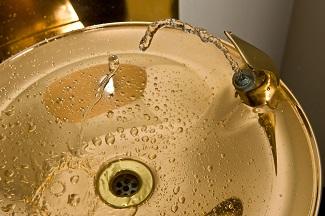Use of Lead Free Pipes, Fittings, Fixtures, Solder and Flux for Drinking Water
 Section 1417 of the Safe Drinking Water Act (SDWA) establishes the definition for “lead free” as a weighted average of 0.25% lead calculated across the wetted surfaces of a pipe, pipe fitting, plumbing fitting, and fixture and 0.2% lead for solder and flux. The Act also provides a methodology for calculating the weighted average of wetted surfaces.
Section 1417 of the Safe Drinking Water Act (SDWA) establishes the definition for “lead free” as a weighted average of 0.25% lead calculated across the wetted surfaces of a pipe, pipe fitting, plumbing fitting, and fixture and 0.2% lead for solder and flux. The Act also provides a methodology for calculating the weighted average of wetted surfaces.Proposed Rule: Use of Lead Free Pipes, Fittings, Fixtures, Solder and Flux for Drinking Water
Past Public Meeting Federal Register Notices, Presentations, and Summary of the Act
Legislative History
In 1986 Congress Amended the Safe Drinking Water Act, prohibiting the use of pipes, solder or flux that were not “lead free” in public water systems or plumbing in facilities providing water for human consumption. At the time "lead free” was defined as solder and flux with no more than 0.2% lead and pipes with no more than 8%.
In 1996 Congress further amended the Safe Drinking Water Act, requiring plumbing fittings and fixtures (endpoint devices) to be in compliance with voluntary lead leaching standards. The amendments also prohibited the introduction into commerce of any pipe, pipe or plumbing fitting or fixture that is not lead free.
In 2011 Congress passed the Reduction of Lead in Drinking Water Act (RLDWA) revising the definition of lead free by lowering the maximum lead content of the wetted surfaces of plumbing products (such as pipes, pipe fittings, plumbing fittings and fixtures) from 8% to a weighted average of 0.25%, establishing a statutory method for the calculation of lead content and eliminating the requirement that lead free products be in compliance with voluntary standards established in accordance with SDWA 1417(e) for leaching of lead from new plumbing fittings and fixtures.
The 2011 RLDWA also created exemptions in SDWA Section 1417 from the prohibitions on the use or introduction into commerce of “pipes, pipe fittings, plumbing fittings or fixtures, including backflow preventers, that are used exclusively for non-potable services such as manufacturing, industrial processing, irrigation, outdoor watering, or any other uses where the water is not anticipated to be used for human consumption” (SDWA 1417(a)(4)(A)). Also exempt are “toilets, bidets, urinals, fill valves, flushometer valves, tub fillers, shower valves, service saddles, or water distribution main gate valves that are 2 inches in diameter or larger” (SDWA 1417(a)(4)(B)).
The Community Fire Safety Act of 2013 further amended the SDWA Section 1417 to include fire hydrants in the list of exempted plumbing devices.
